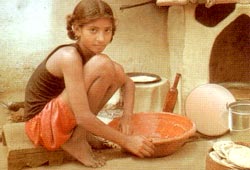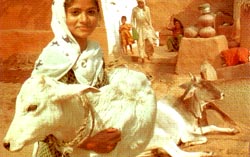Simple Living, High Thinking
Hindu spirituality has been largely nurtured in a rural setting, and scripture recommends a simple life, free from unnecessary complication. Varnashrama-dharma is closely associated with an agrarian culture, which fosters a mood of dependence on God. According to theologians, the village demonstrates the influence of goodness (sattva), the town is compelled by passion (rajas) and sinful places, such as many modern cities, are bound by ignorance (tamas). The whole system of varnashrama-dharma is designed to bring everyone, step by step, to the level of goodness, more easily attained in a rural setting. Sustainability and a peaceful, regulated lifestyle are principal characteristics of sattva-guna.
The early morning hours are also considered sattvic and in India people rise early, between 4 and 6 am. Practically everyone bathes upon rising, making use of a pond, river or hand-pump, or – if relatively well-off – a bathroom. It is common in the morning to see Hindus outside their simple dwellings, slowly cleaning their teeth with a twig from a tree, such as the antiseptic neem. Life is relatively slow, with morning hours dedicated to some form of worship. A light breakfast follows at around eight o’clock. Shops and stalls open quite late, around ten. The main meal is lunch – for the digestion is considered strongest when the sun is at its highest. People take a siesta in the sultry afternoons, and shops and stalls either close, or the shopkeeper takes a snooze. They often open late into the evening, when it is pleasantly cool, and people again throng to the streets and the temples.
Life is very much in contact with nature and the elements. Water is drawn straight from wells or rivers. Cooking is over open fires. Village homes have an earth floor, coated with a mixture of earth and cow-dung, which has antiseptic properties. Animals are very much a part of life. Dogs are not domesticated, and live quite differently than in the West. Cows roam freely and are given much leeway. Wild pigs, often part of the natural scenery are valued for their function of waste disposal. Monkeys are notorious for their mischief and their stealing (eye-glasses are now a favourite!). Camels, ponies, and buffalo are used for pulling carts. In the south especially, elephants are used in temple rituals.There are many stories about snakes, especially the cobra, which is considered to have mystical powers. Today, there are still many physicians who can cure a snake bite by chanting mantras rather than administering a serum. Mysticism and spirituality are woven into the colourful fabric of everyday life.
Women collect waterfrom a well.A rural life involves much contact with the elements.
This girl is cooking chapattis on an open fire. Many household chores are performed whilst squatting on the floor.
Animals are very much a part of a rural lifestyle.
The sadhu (wandering holy man) typifies a simple life and the ability to focus the mind on an inner, spiritual wealth. Simplicity creates a mood of service and dependence upon God rather than an exploitative ethos and reliance on our own schemes to harness and control nature. Householders are also recommended to keep their lives and minds as uncluttered as possible.




